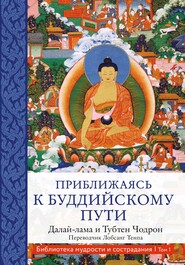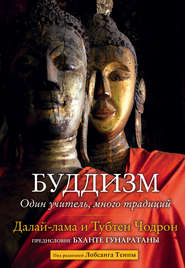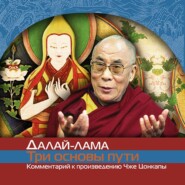По всем вопросам обращайтесь на: info@litportal.ru
(©) 2003-2024.
✖
Awakening the Mind, Lightening the Heart
Автор
Год написания книги
2019
Настройки чтения
Размер шрифта
Высота строк
Поля
Arising from the source of love and compassion
The ship of the awakening mind is well launched.
Above it billow the great sails of the six perfections and the four ways of amassing disciples,
Which are driven by the wind of enthusiastic effort that never slackens.
Perfectly it carries embodied beings across the ocean of the cycle of existence
Landing them on the wish-fulfilling jewel island of omniscience.
I prostrate, placing my head at the feet of the leaders of the spiritual lineage:
The Subduer who is our supreme navigator, the powerful [Buddha];
Maitreya and [his followers] Asanga, Vasubandhu, and Vidyakokila;
Manjushri and [his followers] Nagarjuna and the supreme wise saint Shantideva;
The master of the Golden Isle [of Sumatra] and [his disciple] the noble Atisha;
And [his Tibetan disciple] Drom-tön-pa and his three spiritual brothers [Po-to-wa, Phu-chung-wa, and Chen-nga-wa].
In these lines homage is paid first to the Buddha Shakyamuni as the supreme navigator who expounded the perfect path based on his own experience of the awakening mind and the six perfections (generosity, discipline, patience, effort, concentration, and wisdom). The lineage of far-reaching altruistic activities was passed from Maitreya to Asanga to Vasubandhu and down to his followers. The lineage of profound insight was passed via Manjushri to Nagarjuna and then to Shantideva. The great Indian master Atisha became like a confluence of both these traditions, and what is known as the lineage of the blessings of the practice was passed from him to Drom-tön-pa and the subsequent followers of the Kadampa tradition—the twelfth– and thirteenth century Tibetan practitioners following Atisha noted for the purity and the unpretentiousness of their practice. The author pays great respect to them all.
I prostrate at the feet of the great emanation of Manjushri, Tsong-kha-pa, the second conqueror of these degenerate times,
Who propounded the individual spiritual paths
Of these great pioneers with extreme lucidity and coherence.
The author was a direct disciple of the great Tsong-kha-pa and pays special homage to him by recounting some of his preeminent qualities. Tsong-kha-pa is venerated as among the greatest of Tibet’s saintly scholars. He had fathomless knowledge of both sutras and tantras. His collection of writings testifies to his scholarly credentials; he wrote eighteen volumes altogether. In writing his own treatises, he studied numerous classical Indian texts thoroughly and did exhaustive research to ascertain their intention. When we study his works, we can really appreciate his scholarly acumen and precision. He was especially distinguished for discussing the more difficult and finer points of philosophy, which was rare among the great scholars in Tibet. Bu-tön, a renowned scholar of the previous generation, wrote very extensively, in fact more than Tsong-kha-pa, but he did not deal with philosophical points as thoroughly. Because of this, there is a saying among the scholars of Amdo, northeastern Tibet, “If you need references, consult Bu-tön, but if you have philosophical doubts, consult Tsong-kha-pa.”
When we study the works of different writers, we get some feeling for their personalities. Some go into great detail but are not very clear and precise when it comes to stating theoretical positions. Others are more concise and straightforward when it comes to theories and philosophical tenets. Writers reveal their own personalities in their writing. They are like the human face. Even though everyone has the same number of features within the small area of the face—two eyes, one nose and so on—still no two faces are identical. There are as many different faces as there are people.
Supreme among his wonderful teachings
Are the means for activating the awakening mind.
I shall expound his perfect teaching with absolute accuracy;
Those fortunate to follow the way of the Great Vehicle should pay close attention for true appreciation.
There is a fine tradition according to which writers begin their work by stating their commitment to compose. This serves as an encouraging stimulus to complete their project. Our author here says that he is going to compose his text according to the instructions of his master. Tsong-kha-pa wrote nothing exclusively concerned with mind-training teachings. His disciple, Nam-kha Pel, wrote this text as a supplement to Tsong-kha-pa’s works.
This mind training is called an ear-whispered transmission because its teachings are passed orally from teacher to student. First it gives a historical account of the tradition and then discusses the meaning of the actual text. To demonstrate the greatness of this instruction, the historical account quotes the “Seven Point Mind Training,” the poem by Geshe Che-ka-wa that I explain in this book.
The essence of this nectar of secret instruction is transmitted from the master from Sumatra.
All of the extensive teachings given by Buddha Shakyamuni, the collection of 84,000 teachings, are meant for removing our mistaken attitude, the misconception of self, and for training our minds to benefit others. All these teachings are meant for removing the collection of 84,000 disturbing emotions, as well as birth, sickness, old age, death, and the other sufferings generated by them. Such instructions are referred to as nectar. The Sanskrit term for nectar means “that which grants immortality.” A skilled physician who knows how to administer such nectar properly can relieve a patient from sickness and even death. Similarly, through following such instructions as these, we can be liberated from such problems as death, old age, and so forth.
The practice of the awakening mind is like just such an elixir. If you practice in the tradition of those intent on personal liberation, of course you can attain freedom from death, old age, birth, sickness, and even the cycle of existence. But it is only by generating the awakening mind, supplemented by other practices, that you will be able to attain the state of Buddhahood. Therefore this practice of mind training, which is a means to generate the awakening mind, is actually the essential practice. This instruction is called the essence of the nectar because by following it you can achieve the state of immortality, which is actually liberation. There are two methods explained in the Buddha’s teachings: the method that leads to achieving personal liberation and the method that leads to the fully awakened state of a Buddha. All these traditions were held by the great teacher from Sumatra, known as Ser-ling-pa. Atisha (982–1054 C.E.) received his training in the awakening mind especially from Ser-ling-pa.
Atisha, the great Indian master, had coundess disciples in India, Kashmir, Nepal, and Tibet, but of these the greatest was Drom-tön-pa (1005–1064). He was the real holder of the lineage of Atisha. He was a great practitioner, who even to ordinary perception had achieved the awakening mind. It is due to his kindness and hard work that the Kadampa tradition came into being in Tibet. Drom-tön-pa in turn had many outstanding disciples, but there were three main ones, Poto-wa, Chen-nga-wa, and Phu-chung-wa, known as the three Kadampa brothers. Chief among these was the great spiritual master Po-to-wa (1031–1106), who inherited the mind training lineage. Po-to-wa was extremely successful in developing the Buddhist doctrine and focused primarily on the thorough practice of the six principal texts of the Kadampas.
Po-to-wa’s main practice was generating the awakening mind. He had more than two thousand disciples from all regions of Tibet determined to attain liberation. Two from central Tibet were compared to the sun and the moon, the great Lang-ri Tang-pa Dorje Seng-ge (1054–1123) and Sha-ra-wa Yön-den Drak (1070–1141). Sha-ra-wa possessed the complete instruction and transmitted his lineage to more than 2,800 monks. Of his four principal disciples who were responsible for passing on his lineage, Che-ka-wa was responsible for the teachings on mind training and generating the awakening mind.
Che-ka-wa once heard the “Eight Verses for Training the Mind” by Lang-ri Tang-pa, which caused him to develop a strong interest in this teaching. He visited Lhasa in search of more teachings on mind training. Some of his wise friends told him that because a spiritual master of the Great Vehicle tradition should be worthy of esteem, he should seek out either the great Sha-ra-wa or Ja-yul-wa. Accordingly, he visited Sha-ra-wa, who was staying at the House of Sho in Lhasa. When Che-ka-wa arrived, Sha-ra-wa was giving a teaching on the levels of those who aspire for liberation. At first Che-ka-wa was not very impressed, because he did not find what he was seeking. The mind training practice of exchanging oneself with others in order to develop altruism was not even mentioned. Afterward, he felt confused and began to wonder whether such a practice of mind training still existed and whether this master possessed the lineage.
The next day, while the monks were making their alms round, Che-ka-wa found the great master circumambulating a stupa. He immediately spread out a mat and asked him respectfully to sit down, saying, “I would like to discuss with you certain things about which I am unclear.”
Sha-ra-wa replied, “Since you are a great teacher yourself, what is it that is still unclear to you? I explained everything very clearly when I was seated on the religious throne.”
Che-ka-wa then recited the “Eight Verses for Training the Mind” and said, “There are practices here that are useful when, because of my untamed mind, I sometimes face problems like not finding a place to stay or being harassed by others. If I do this practice of mind training, giving the benefit to other people and accepting defeat for myself, I find it very useful. Sometimes, of course, it is extremely difficult to put such mind training into practice, so what I want to ask you is, is mind training appropriate to practice, and can it become a cause for attaining Buddhahood?”
Then Geshe Sha-ra-wa, who was actually turning the beads of his rosary, said, “There is no doubt about the usefulness of the practice of mind training. Of course, whether it is suitable for you or not is a different matter. If you do not desire Buddhahood, that is one thing, but if you really wish to attain enlightenment, then this practice of mind training is essential.”
So his actual answer was, “Whether you like it or not, if you really desire Buddhahood, then mind training is the only way.” Che-ka-wa thought that since his reply was so forthright, Sha-ra-wa must have great personal experience of the teaching. Next he asked, “Since this mind training instruction is an authentic teaching there should be scriptural references for it. Can you tell me what the source is?”
Sha-ra-wa replied, “Who would not regard it as derived from the work of the exalted Nagarjuna? The authentic source of this teaching is to be found in his Precious Garland, where it says, ‘May their unwholesome deeds bear fruit for me. May all my virtue bear fruit for others.’”
Che-ka-wa responded, “I like this teaching. Kindly give it to me.”
Sha-ra-wa advised, “The practice of this instruction requires constant effort over a long period of time, but if you are prepared to make such an effort, you can take these teachings from me.”
Che-ka-wa then inquired, “If this practice is imperative for attaining Buddhahood, why didn’t you refer to it earlier when you were teaching? Why did you make no reference to mind training then?”
Sha-ra-wa responded, “What’s the use of giving a great teaching like mind training if no one really wishes to practice it?”
I think we need to pay more attention and respect to this ancient tradition of not teaching the Dharma to anyone and everyone without discrimination. In the past, teachers did not teach just anyone who came to them, nor did they give just any teaching that was requested from them. They sought to ensure that appropriate teachings were imparted to appropriate disciples. In that way, only truly dedicated and spiritually oriented disciples became involved in the Dharma, and as a result their practice was very successful. Teaching tantra was severely restricted, and only the most capable and devoted disciples were permitted to receive it. In recent times, such restrictions have been waived, and even tantra has become the subject of popular public teachings.
After making three prostrations, Che-ka-wa went back to where he was staying and, opening a copy of Nagarjuna’s Precious Garland, found the quotation that Sha-ra-wa had recited. Then, setting aside all negative thoughts, he spent more than two years at the place called Sho putting these teachings on mind training into practice. Then he spent six years at a place called Gye-gong and another four at a place called Shar-wa. Altogether, Che-ka-wa spent fourteen years engaged in developing the awakening mind under his teacher’s guidance. Che-ka-wa gained a perfect realization of the awakening mind through emphasizing the exchange of oneself with others. Later he said, “All the sacrifices I have made and the hardships I have undergone have now borne results.”
For great beings such as these, spiritual knowledge was not confined to mere intellectual understanding. They were more concerned with spiritual realization than anything else. Neither teacher nor student was under any of the pressure that is so common these days. Consequently, they followed what we might call an experiential method. In this process, students would progress according to their experience of what they had already been taught. A text would not be taught from beginning to end without a break but gradually, in stages. Students would be taught the next part only when they had gained sufficient confidence and experience of the preceding section.
The Kagyu school still teaches Mahamudra, the Great Seal, in this fashion. Dzogchen, the Great Completion, is also taught in this way. But, in general, people these days are in such a hurry that it is common for the entire presentation of the stages of the path to enlightenment to be taught in a very short time. This method of teaching is not so effective in itself, and students do not pay the same degree of attention and respect. They just listen to the teaching as if it were some kind of a story.
Among all the classical Indian treatises, Shantideva’s Guide to the Bodhisattva’s Way of Life is the most authoritative when it comes to the mind training teaching of equalizing and exchanging self with others. Our author here has taken this text as the foundation and inspiration of his own writing. With the statement, “I shall present the instruction according to the tradition of Tsong-kha-pa,” our author concludes his account of the source and great qualities of this instruction. The text says:
You should understand the significance of this instruction
As like a diamond, the sun, and a medicinal tree.
This time of the five degenerations will then be transformed
Into the path to the fully awakened state.
A precious diamond removes poverty and grants all your wishes; even a fragment of diamond is regarded as an excellent ornament, surpassing even the best golden jewels. Similarly, even if you implement only a part of the practice of generating the awakening mind, such as the practices of compassion or tolerance, it will still outshine all other practices. Even the practice of one such factor will bring about a special effect within the practitioner. A bodhisattva, one who champions the awakening mind, may not be actively engaged in the practice of wisdom and the realization of emptiness, but because of his or her realization of the awakening mind, that person will still outshine those embarked on personal liberation only and will maintain the name of bodhisattva. She or he will be able to work for the welfare of other sentient beings. Even if you simply generate the aspiration to the awakening mind and are unable to put it directly into practice, you will still exceed other practices, like those of beings seeking only personal liberation. Through such practices you will be able to remove the poverty of the cycle of existence.

















